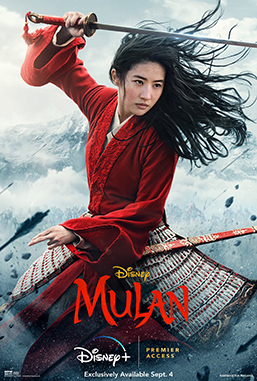Disney’s live-action Mulan brings action and extravagance (but not honor) to us all

Walt Disney Studios Motion Pictures [Fair Use]
The newest “Mulan” has split many fans as to whether it lives up to the animation.
September 15, 2020
If you’re boycotting “Mulan” because of lead actress Liu Yifei’s support of Hong Kong police, don’t worry, you haven’t missed a must-see.
In 1998, Disney released the animated version of “Mulan,” which was based on the ancient Chinese text “The Ballad of Mulan” and became a milestone for Chinese representation in American movies. The new live-action adaptation features an all-Asian cast and is much closer to the original story, taking out some of the animation’s central elements. Sadly, it took out the authenticity of most struggles as well, and what’s left is a dishonor to both the ballad and the animation.
The premise of the adaptation remains the same: Mulan (Liu Yifei) disguises herself as a man to join the army in the place of her ailing father (Tzi Ma). She prevents bad-guy Bori Khan (Jason Scott Lee) and shapeshifting witch Xian Lang’s (Gong Li) army from taking over Imperial City, saves The Emperor of China (Jet Li) and returns home to open arms. Notable but underdeveloped subplots include bonding with her comrades, grappling with her dishonesty toward her commander (Donnie Yen) and cultivating her chi.
A long-overdue adaptation of a classic combined with a star-packed cast and a massive production budget, the live-action Mulan was destined to make headlines. However, lazy writing and pandering toward the Chinese market have kept it from living up to its potential. Mulan steps out of its predecessor’s shadows but fails to live up to its legacy.
Mulan as a standalone
An extravagant visual feast, the new “Mulan” is engaging but not overwhelming. It is very much a Chinese movie, with consistent (albeit somewhat muted) color palettes. Much like its wardrobe and set, the choreography is also well-coordinated and further emphasizes the Chinese ideal of strength in unity. The film’s $200 million production budget was well spent, resulting in close-up fight scenes, dramatic battle sequences and stunning aerial shots.
However, no amount of money, martial arts or meticulous attention to detail could have saved the lackluster plot. The movie spreads itself thin by combining too many irrelevant characters and subplots without fully developing any of them, resulting in a hodgepodge of loosely related ideas. Mulan herself has little time for growth, promoting the idea that strong women must be flawless with superpowers and Mary Sue traits. You’d be hard-pressed to find faults in her personality beyond daring to be a woman. Much of the conflict that is necessary for growth is simplified or cut altogether, and the obstacles that do arise are solved with minimal effort.
My biggest gripe is the movie’s concept of chi. Instead of being strong because of her smarts, grit and character development, Mulan has magical powers caused by her chi, a mystical energy source, making her a skilled fighter despite her minimal training. It’s only addressed when the movie wants some quotable dialogue, and viewers never get a clear explanation of how it works. It’s also strangely reminiscent of Star Wars, which is not a comparison you should make when watching a film set in ancient China.
The only other notable female character is the witch, a secondary villain. She serves as a great foil to Mulan: they both have a powerful chi that the male-dominated society frowns upon. However, the witch’s disillusionment with society caused her descent into evil, while Mulan’s loyalty toward her country and family earns her eventual acceptance. I’m unimpressed by how the writers wasted the character’s potential, though. The witch’s ending is poorly-written, barely-justified and sets up the least satisfying path to victory for Mulan. Furthermore, the lack of closure she gets undermines the entire message of empowerment that the movie is meant to send.
Because of this, the movie goes through the motions of promoting female empowerment but fails to deliver anything of substance. Sure, there are obligatory shots of Mulan kicking butt while embracing her femininity. More tellingly, however, she is the only woman who’s not inconsequential, relegated to strict social roles or shunned. Though this is an accurate depiction of ancient China, we don’t know if Mulan’s triumphs bring change for other women. If Mulan is meant to be the success story of a woman who refused to let society limit her, it’s awfully unsatisfying if society remains the same after her story ends. Perhaps this is an intentional choice, as “Mulan 2” is reportedly in the works and could explore the social ramifications following Mulan’s victory.
Overall, the live-action adaptation is sleek and polished but fails to dig deep. It has its own strengths and weaknesses and is able to establish itself outside of the 1998 animation’s legacy, though not necessarily for the better. It’s refreshing to watch something new rather than a repackaged story, but the adaptation misses much of the magic that made the original successful.
Mulan compared to the 1998 animation
There are notable differences between the new movie and the animation many grew up watching. The animation explores inner conflict and self-discovery, while maintaining a balance of humor in classic Disney fashion. These themes, as well as some beloved characters, are absent from the adaptation for the sake of seriousness, realism and Chinese appeal, but not for the better.
Commander Shang was split into two characters—an older army commander and a soldier that serves as a “love interest” to Mulan. The commander causes much of Mulan’s worry over concealing her identity, but he quickly accepts Mulan after her gender reveal, an easier resolution compared to the animated Mulan’s fight for acceptance. The love interest, on the other hand, was entirely unnecessary. His relationship with Mulan evolves into a hesitant friendship by the end of the movie with little romantic subplot. The execution could have worked if the movie ever decided how important these two characters are, but they appear in oddly placed scenes with rushed transitions that detract from Mulan’s self-reflection. I’m also disappointed neither of them broke out in song during the training montages, but I can’t say I’m surprised.
Mushu is also cut, replaced with a stoic guardian phoenix that pops in and out of the movie. Though Mushu was about as insightful as a fortune cookie in the animation, he made for great comic relief and provided some iconic lines that I still quote today. Without him, the movie feels overly stiff, and it’s painful to listen to monologues about honor if Mushu isn’t delivering them. However, his exclusion is expected. This movie is counting on the Chinese market for much of its revenue, and Mushu’s caricaturistic representation of Chinese culture contributed toward the animation’s failure in China.
Disney took a step further in wooing Chinese audiences by replacing the animation’s themes of independence and self-determination with Chinese values of filial piety, loyalty and honesty. Pandering toward Chinese markets at the expense of western ones is a risky gamble, though it’s unclear if Disney could have struck a balance and appealed to both. It’s also unclear if Disney’s reliance on Chinese markets will be worth it, as many viewers in China have pirated the movie before its official Chinese release.
Whatever the reception in China will be, the movie’s sharp break from the animation and unending seriousness will likely be the cause if it bombs in America. If you want something on par with the animated “Mulan’s” plot, humor and depth, just rewatch it. I can’t imagine picking this case of wasted potential over a beloved classic.
“Mulan” is what I expected, but it falls short from what I hoped for. It’s a mature, fresh take on a legendary ballad, but it loses much of the 1998 animation’s charm. Even so, this live-action adaptation is distinct enough to establish itself outside its predecessor. “Mulan” is not a movie worth fighting for, but personal preferences will determine whether it’s worth paying $30 for.








